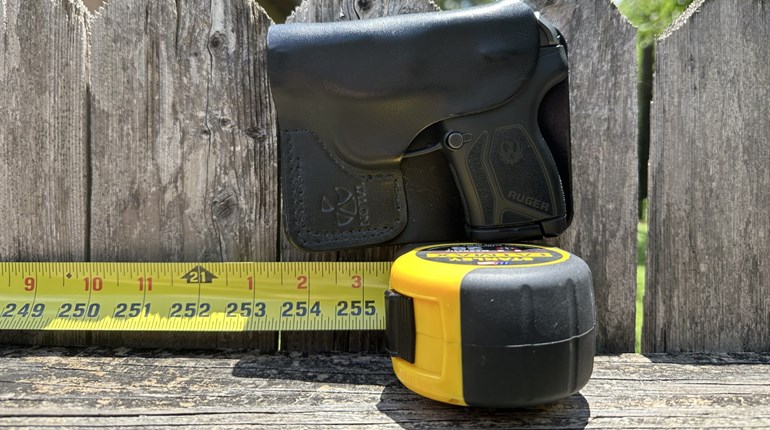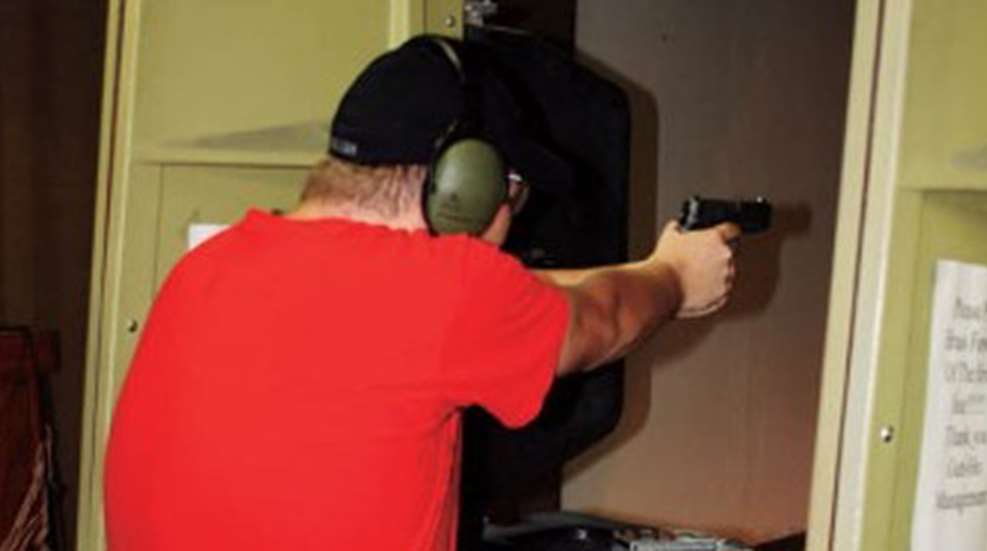
Depending on your location, an indoor range may be your only viable option for training and practice. They can be loud, dirty and have more rules than a teenager's mother, but indoor ranges still have something to offer. Let's take a look at the indoor shooting range and how you can get the most out of your time on the firing line.
Marksmanship Fundamentals
It is always good to start with the fundamentals. As a matter of fact, any true student of the gun must master the fundamentals to achieve repeatable success. It's been said by wiser men than me that there really is no such thing as high-speed or advanced shooting. There is merely a mastery of the fundamentals.
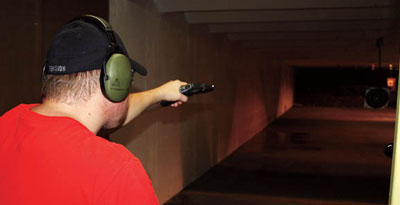
When you arrive at the range, it's never a bad idea to remind yourself to focus on the fundamentals of clear front-sight focus and a smooth, deliberate trigger press. Check your grip and ensure your finger is placed on the trigger so as to allow a smooth press directly to the rear. Take your time and make every shot count. Think of each shot fired as a pass-or-fail test. If the shot strikes the center of your target, you pass. If it did not, you failed. If your round didn't strike where it was supposed to, you must be honest with yourself and consider why.
A miss or a poor shot is not necessarily a bad thing—if you learn from it. However, if you are missing the target and can't figure out why, it's probably time to get some professional instruction.
Single-Hand Shooting
One of the benefits of employing a handgun is, during a crisis situation, you can operate the pistol with only one hand. Obviously we have more stability when using two hands, but that is not always practical, particularly in a personal-defense scenario. You might have an object in your support hand such as a flashlight, or you might be holding something you are not willing to let go. Your child's hand is a good example.
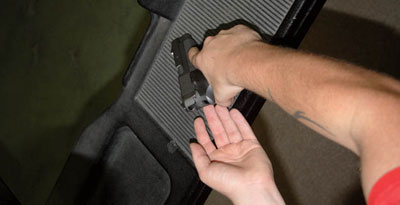
When firing with only the strong or support hand, it is more critical than at any other time to focus on your sights and your trigger control. The front sight must be in line with your dominant eye. This is quite natural if your shooting hand and eye dominance coincide. A challenge occurs when the hand holding the gun is the opposite from your dominant eye. Again, one of the benefits of a handgun is it allows you to easily cant the gun to align the front sight with the dominant eye. You don't need to close one of your eyes. Keep them both open and align the front sight with your dominant eye. When I am working this particular single-hand drill, I like to put at least one full magazine through the gun with my strong hand only, and then switch to my support hand only.
Drills from the Table
I've practiced at a lot of indoor ranges all over the country, and gun-handling rules vary from one to another. A common thread I have discovered is few will permit the shooter to draw from a holster. You may be fortunate to belong to a range that allows it, but my experience is most don't.
If this is the case, you can still practice presentation by prestaging your handgun on the little table almost all ranges provide. I call this the pick-up drill. Start with the gun loaded and in the condition you would actually carry it—with any manual safeties you might have engaged in the holster.
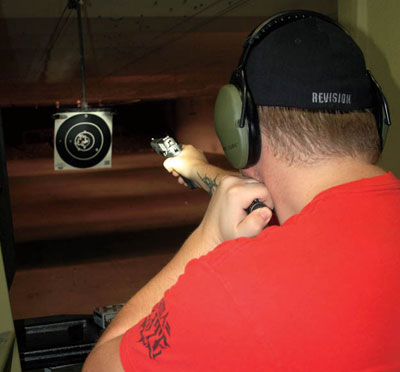
Begin the drill with your hands by your side. On a signal or command, pick the gun up and engage the target with a single shot. Once you are comfortable that you are hitting the target in the preferred area, move on to controlled pairs or multiple shots. This might not be as valuable as drawing from the holster, but keep in mind, you can always practice presentation from the holster at home with an empty pistol.
Lights
One of the benefits of using an indoor range versus outdoor is the ability to practice with tactical lights and laser sights. It doesn't matter how many lumens your tactical light emits, on a sunny day you won't be able to see the beam and few outdoor public ranges permit you to shoot after sundown.
The indoor range setting should enable you see the beam from your light. When I'm alone on the range, I like to turn out a light or two—or all of them—and practice the different flashlight techniques. There are a number of different ways to use a hand-held light in conjunction with a firearm. The modified FBI, neck-index and Harries techniques immediately come to mind.
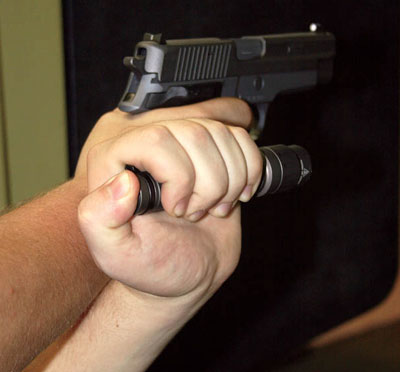
Using a hand-held light with a live firearm is not a skill you simply pick up. It's always better to get some professional training. After you've received that education, you'll need to practice to maintain a level of proficiency. When practicing flashlight techniques, you should work on form first. Speed will come once the skill is mastered.
Lasers
When it comes to working with laser sights, the indoor range offers the best environment in which to see them clearly. The sun has a nasty habit of washing out red lasers. That's fine, of course, because we have iron sights to use in normal light conditions.
I fully understand the pros and cons when it comes to laser-sight systems. Some folks go nearly apoplectic when you bring up the subject, and that's fine. A couple of decades back, I recall a crusty old Marine commenting on the then-new tritium sights. He saw them as an expensive novelty with no practical value and referred to them as "nuclear sights."
Laser sights are not a magic wand, but they certainly have their place. Indoors, in poor light conditions and when the shooter is firing from an awkward position are all good times to employ a laser sight. The drawback with lasers is far too many gun owners think purchasing a laser negates the need to practice. That is not the case. Poor trigger control is poor trigger control, laser or no laser. Just as with any type of equipment, in order to get the most out of your laser-sighting system you need to actually get to the range and practice with it. The indoor range is a perfect setting.
Working the Gun
The indoor range setting provides a good opportunity to work on your gun-handling skills. By this I mean the skillful manipulation of all the manual controls that are unique to that particular firearm. Depending on the make and model, you will have any number of manual controls on your handgun: decocking levers, manual safeties, slide releases, cylinder latches, etc. Every manufacturer puts its special touch on these areas. For instance, the Beretta 92 and SIG Sauer P226 both have decocking levers, but they are in completely different locations. One is located on the slide and the other on the frame.
While at the range, take the time to thoroughly familiarize yourself with the controls and practice operating them. I've seen a number of shooters with double-action pistols equipped with manual safeties and decocking levers. They'll charge the gun with a full magazine and fire every round without ever engaging the safety or decocking the action.
This is fine if all you ever plan to do is shoot paper targets on the range. However, if the gun is used for concealed carry or kept for self-defense, ignoring the operation of the gun's controls can lead to poor gun handling during a crisis. Take the time on the range, when no one is shooting at you, to completely familiarize yourself with all characteristics and controls of your gun.
9 mm Carbines
We have been focusing on handguns, but this subject meshes with our indoor range topic. Like the holster issue, some indoor ranges will allow you to practice with centerfire rifles, but I've encountered just as many that don't.
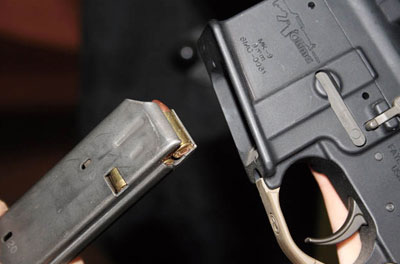
If your range only allows handgun ammunition, one of the new breed of 9 mm carbines might just be the ticket to long-gun practice. A number of black-rifle manufacturers are producing AR-style guns chambered in 9 mm. I've had tremendous success with the models from CMMG.
Before you whip out your 9 mm black rifle on a pistol-caliber-only range, be sure to let the guy behind the counter know it is chambered in 9 mm, not 5.56 NATO. This should prevent hurt feelings on both sides resulting from any confusion or misunderstanding.
Regardless whether your range allows centerfire rifles, 9 mm training ammunition will run you half the cost of 5.56 NATO fodder. Of course, the 9 mm carbine can also be loaded with controlled-expansion ammunition and pressed into service as a home-defense tool.
Indoors or outside, training and regular practice are the keys to success. Many well-meaning, uninformed indoor range owners will implement more rules than the International Olympic Committee in an attempt to make the range extra safe. The fact is, the best way to make everyone safer is to have well-trained shooters who practice often.
Should you find yourself in a position where the indoor range is your best option, with a bit of forethought you can have a valuable practice session. And practice is never a bad thing.












